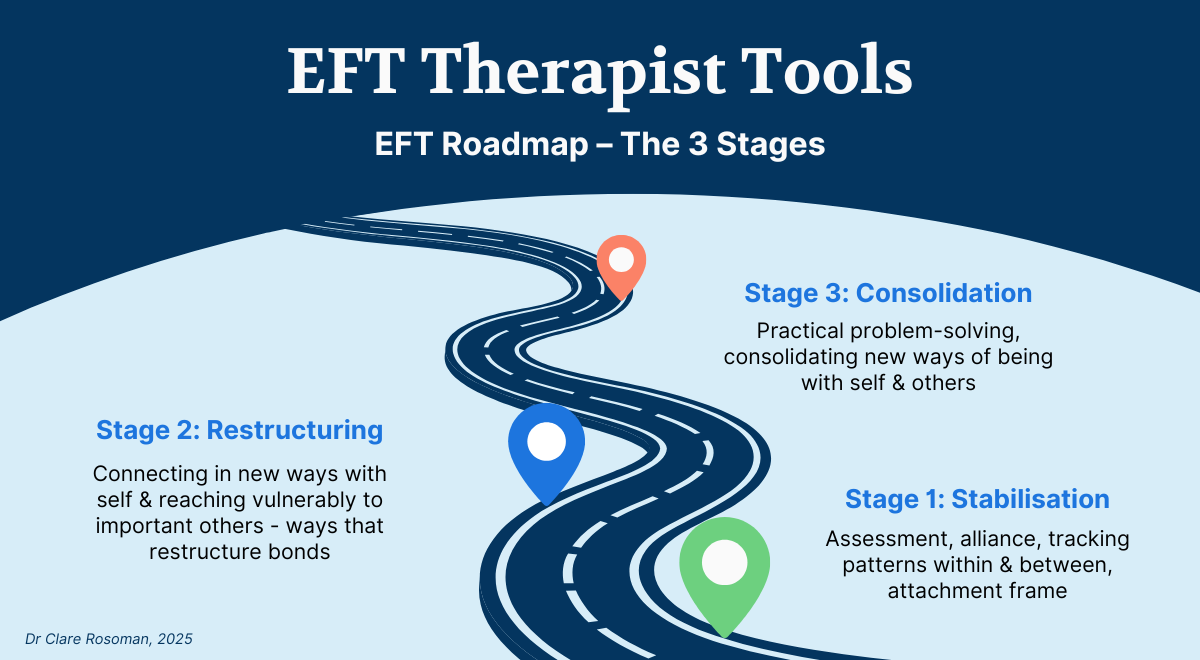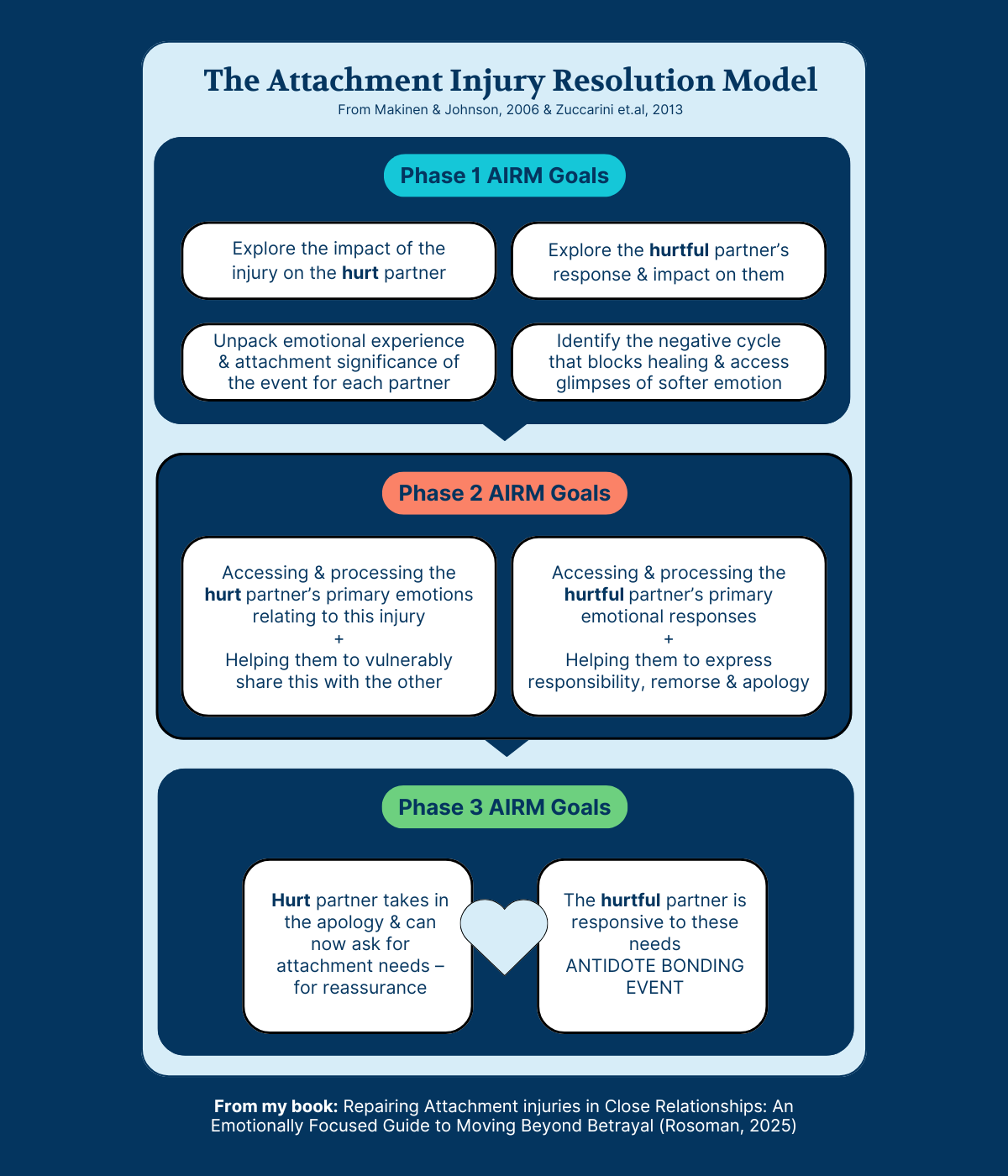Article summary
- Emotionally focused therapy (EFT) helps couples rebuild secure bonds by addressing emotional disconnection and repetitive conflict patterns.
- Attachment injuries – such as betrayal, secrecy or abandonment – require more than standard repair; they call for a structured, emotionally engaged process.
- The Attachment Injury Resolution Model (AIRM) supports couples to identify reactive cycles, express pain vulnerably and meet each other’s needs.
- Stabilisation is essential before applying AIRM, ensuring both partners are emotionally ready for the deeper healing work.
- Healing occurs through “antidote bonding events” – moments of shared vulnerability, empathy and genuine remorse.
- Dr Clare Rosoman, Director of the Brisbane Centre for EFT, will present on this topic at the APS Festival of Psychology, 16-18 May on the Gold Coast.
When a deep betrayal ruptures trust in a relationship, it can feel irreversible. Often clients and psychologists alike feel like nothing can be done to repair a broken bond between individuals.
But emotionally focused therapy (EFT) offers psychologists a roadmap for guiding clients through some of the most painful terrain in relationship repair – a journey that leads not only to healing, but to the possibility of a stronger, more secure bond.
Emotionally focused therapy is an evidence-based approach to couples therapy with over 35 years of research supporting its efficacy. Recognised as an evidence-based treatment, EFT is designed to help couples restructure emotional bonds and rebuild secure relationships following some form of attachment injury, such as uncovering secrecy or boundary-crossing behaviours (see three stages of EFT in diagram below).
"It's an evidence-based model for improving relationship satisfaction and building secure connections in loving bonds," says Dr Clare Rosoman, Director of the Brisbane Centre for EFT, clinical psychologist and upcoming speaker at the APS Festival of Psychology.
At the heart of the model is a focus on emotion and interaction patterns – those predictable, repetitive dynamics that couples get stuck in during conflict. Rather than pathologising individuals, EFT helps partners recognise and exit these cycles by fostering authentic, heart-led communication.
“It's a bottom-up model,” says Dr Rosoman. “We follow emotion and work in the present to create new interactions that shift attachment positions – which, in turn, changes communication.”
.png)
Figure 1. EFT roadmap – the three stages
What is an attachment injury?
Not all relational hurts are equal. In EFT, an attachment injury refers to a betrayal, abandonment, or violation of trust at a moment of critical need – a moment that redefines the partner as unsafe or unreliable, rather than a safe haven.
“It’s not the usual rupture and repair that comes with misattunements or hurt feelings,” says Dr Rosoman. “An attachment injury creates a fundamental shift in how a partner views the relationship. It’s like a snap in the fabric of trust.”
Dr Rosoman identifies four key categories of attachment injuries:
-
Sexual and emotional betrayal – such as infidelity, breaking exclusivity agreements, or emotional affairs.
-
Violated boundaries – secrecy, lies and unilateral decisions that exclude the partner (e.g., hiding job loss or tampering with contraception).
-
Abandonment at a time of need – e.g., failing to show up during illness, childbirth or major life transitions.
-
Threatening safety or livelihood – acts that compromise emotional or physical security (e.g., violence, drink-driving or unprotected sex with another partner).
The process of healing from these injuries is encapsulated in a mini-model within EFT: the Attachment Injury Resolution Model (AIRM). Used in Stage 2 of EFT (see Figure 1), once initial stabilisation is achieved, the AIRM supports couples in processing the injury and rebuilding trust through live emotional engagement.
It unfolds in three major phases:
Phase 1: Track the cycle that's blocking the healing
The first step is to uncover unhelpful cycles that a couple might be entering that could be preventing them from healing and framing these in attachment terms.
"Think of it like taking the inflammation out of a wound. You're working to stabilise the system to create safety that will allow you to go on to do the important healing work," says Dr Rosoman.
Phase 2: Vulnerable sharing and empathic responsiveness
"The hurt partner is supported to express their pain vulnerably – which can be a really difficult task, as many are walled off or defensive."
The therapist helps them “reach out with their pain” in a way that invites empathy, not blame.
Simultaneously, the hurting partner is guided to receive this pain non-defensively. Their own guilt, shame or fear may be triggered, but the therapist scaffolds a new emotional interaction where genuine remorse emerges.
“When the hurtful one can say, ‘I know – it hurts me to know I hurt you,’ and it lands, that’s where the bond starts to repair."
Phase 3: Asking for and meeting attachment needs
Next, the hurt partner must name their needs – often for comfort, reassurance or emotional presence. This, too, is challenging. Many hurt partners would rather not rely on the one who caused pain. But when they can ask and receive, and the partner responds authentically, a powerful “antidote bonding event” occurs, says Dr Rosoman.
"They're sharing the pain back and forth, but they're also able to turn to each other for their needs."
This exchange often brings healing to both parties: the hurt one receives soothing; the hurtful one regains agency and experiences emotional repair.

Figure 2. The Attachment Injury Resolution Model
Preparing for the work: Stabilisation and preconditions
Crucially, AIRM cannot begin until the couple is ready. As outlined above, phase 1 of EFT involves stabilising the couple’s dynamic by identifying and helping them exit reactive cycles – the blaming, defending, withdrawing or appeasing that blocks repair.
Dr Rosoman uses the metaphor of a broken limb: before healing can begin, the damage must be assessed, the wound cleaned and the limb splinted.
The same logic applies to attachment injuries. Each partner is also given roles and expectations:
- Hurtful partner: Demonstrate commitment through actions; be transparent (especially about their personal devices and movements, but only voluntarily and temporarily); and be prepared to witness the other’s pain.
- Hurt partner: Manage reactivity; avoid abusive behaviours; and keep an open heart. They’re also encouraged to be cautious in how much detail they seek about the injury – enough to no longer feel in the dark, but not so much that the information becomes retraumatising for them, suggests Dr Rosoman.
Holding the heat, holding the hope
Helping a couple to repair attachment injuries is some of the most emotionally demanding work in relationship therapy, says Dr Rosoman. Clients often arrive with intense pain, reactivity and urgency – wanting immediate fixes when the process takes time and emotional endurance.
It's important to outline this up front and set expectations, she said. The road to recovery is long – as with many other therapeutic approaches – but it's incredibly satisfying work, she adds.
Dr Rosoman underscores three essential supports for psychologists undertaking this work:
- Training in an evidence-based model like EFT for couples. APS is hosting an EFT workshop in Melbourne from 4-7 June 2025.
- Clinical supervision to process difficult emotions, manage complex dynamics and reflect on one’s own attachment history.
- Ongoing self-reflection to ensure personal beliefs about trust and betrayal don't unconsciously influence the therapeutic process.
“You have to hold the hope and help them to take out the heat – or the sting – from the attachment injury,” she says. “It’s possible to be stronger in the broken places – to come out of this with a more secure, more resilient bond.”
Advice for therapists looking to utilise EFT
For psychologists committed to deep, reparative work, EFT offers a robust, research-backed path for helping clients move from heartbreak to healing.
While grounded in rigorous clinical training and structure, EFT also asks the therapist to model authenticity, presence and vulnerability – serving as a secure base for both partners during moments of intense emotional exposure.
In EFT, therapists are not neutral observers; they are emotionally engaged facilitators of connection, helping each partner move through reactivity and into repair.
Rather than relying solely on interpretation or insight, EFT therapists co-create experiential shifts – drawing on the power of emotion and attachment in real time to help rewire relational dynamics.
"It feels really meaningful and authentic," she says. "We [the psychologist] don't have to be behind the sheet experts; we get to be fellow humans who also hurt in the same ways, who have the same attachment needs as our clients, who have the same emotional experiences. We get into resonance. We co-regulate. We get through it collaboratively."
For psychologists accustomed to more cognitive or interpretive models, this shift can be both liberating and demanding. It requires not just theoretical competence, but emotional congruence and the ability to tolerate distress while guiding others through it.
As Dr Rosoman puts it, “We become the safe haven and the secure base for each person in the relationship – not above them, but with them.”
Hear more from Dr Rosoman and other experts at the APS Festival of Psychology from 16-18 May. There’s still time to register for the chance to connect with your peers and hear from a range of global experts.